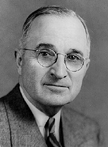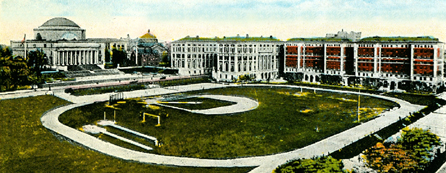
|
A Report to the Class of
1921, |
|
By the late Frieda (Wyandt) Everett |
My Hiram connections began before I was born. My mother’s foster family, (in Angola, Indiana) were Kinney’s, and one of the Kinney cousins was married to Minor Lee Bates, later to be president of Hiram College. My Father, J. W. Wyandt, was a school superintendent who was given credit by Ralph Goodale for sparking the interest in literature which led him to a professorship in the College. At Hiram (we by then had moved to Bryan, Ohio) I was joined by others of the Kinney tribe -- Elizabeth and Martha Lewis, both of whom are now dead; Mary Woodhull, and of course Mary and Gaylord Bates. I managed to live down this connection with Prexy’s family and, with the help of summer credits from Bowling Green, jumped from the Class of '22 to '21 in my last year.
|
| Hiram College campus |
My hopes for an advertising job I’d been offered in Cleveland crushed by the depression of 1921, I became low- teacher- on- the- small- totem- pole in the High School of Eden (nee Mudsock), Ohio, and the year there was distinguished chiefly by hearing myself denounced from the pulpit of the Christian Church as a heretic ruining the faith of Eden’s children -- I had dared to transmit a bit of the comparative embryology I had learned from Professor Turner! That Professor Turner was qualified to preach in that church cut no ice: "Hiram is considered pretty radical by many in the church." The preacher admitted he had no degree.
With the $375 or so I’d saved up that year (room and wonderful board were $7 a week) and the encouragement of a family friend who’d been one of the first women chemists, I set off for Columbia University and its School of Journalism. The “S of J” dean sniffed at my Hiram record and made me take two years, rather than the expected one year, to get my B Litt degree, but by my 1924 graduation I still had $375 -- and considerable professional (as well as hash-slinging) experience. I’d done assignments for the New York Daily News -- the most interesting getting a job a day as a poor girl coming, untrained, into New York. I worked as a bus girl, demonstrated in a Fifth Avenue toyshop window (with Everest Derthick and other Columbia classmates stranding outside trying to throw me off), was a theater usher, and as a climax, drove a taxi for a day in New York. I was one of only 10 women to have NYC hacking licenses, and got it the hard way. The paper’s advertising department, however, procured the taxi for me. I also worked the next summer and part-time my last year for a public relations firm handling expositions at Grand Central Palace.
|
|
|
Campus of Columbia University, New York City |
I missed the Pulitzer Scholarship (scuttlebutt had it because I went to sleep in Walter B. Pitkin’s short story class) so I decided to have my own year abroad. On the strength of the News stories I suggested doing the same in Europe for the Sunday World and got the go-ahead -- they would pay me double space rates and anything from syndication, but no expenses, so I set sail on July 3 for a fabulous year. A chain of friendships started on the boat that is still binding us today. I set out in London to get my jobs, although, with England in a depression, it was strictly illegal for foreigners to work. My first was as a house parlor maid at Harrow-on-the-Hill for a retired surgeon who belonged to the Royal Automobile Club where the week before I’d dabbled at golf with my public relations boss, in London for an advertising conference. I lived in a girls’ hostel on the New Kent Road in the heart of London’s East End, tried out for the London Hippodrome chorus and lasted three rehearsals, got a job driving an actress’ car, worked as a land girl on an island in Lake Windemere, sold ribbons in an Edinburgh department store and was a “tenter” (learner) in a Lanchashire cotton mill. After the series was finished, I helped Mrs. Joseph Comyns-Carr write her "Reminiscences" of Victorian artistic circles and did occasional articles for the London Express and Evening Standard and for the Glasgow Herald. [Note -- Joseph Comyns-Carr was a famed English art and drama critic, gallery director, author, playwright, poet and theater manager. His wife, Alice Vansittart Strettell Carr, published her book in London in 1926.] After an ensuing three months on the Continent I was hungry for a paycheck and returned to New York.
There I was
just getting launched as a free-lance writer when a job on the then new and now
unlamentably demised New York Evening Graphic opened up and I joined
Walter Winchell and Ed Sullivan on that flamboyant sheet.
It was good experience, however, and there were highlights like riding in
Lindberg’s ticker-tape parade up Wall Street, going down the Bay to meet Queen
Marie, covering music and seeing Schuman Heinck backstage, interviewing Deems
Taylor, Sherwood Anderson (who’d “had a girl in Bryan once”), and
Hiram’s own Vachel Lindsey, with whom and his wife I had a delightful lunch.
There were no eight-hour days, and I did everything from cutting down True
Story Magazine’s long fiction to fit our page (it was a Bernard Macfadden
publication) to having my own columns: “Betsy
Patterson” (slightly spoofing society) and the “Earl of Gramercy”
(definitely spoofing everything). Particularly
gratifying was a chance to cover the British General Strike for the Graphic.
By the time I got there by boat the strike was over, but I toured the
coal mining regions and heard of the appalling conditions that led to the strike
and heard also the marvelous Welsh voices singing in innumerable small union
halls.



Sherwood Anderson, Vachel Lindsey, Deems Taylor
My Graphic stint was followed by a year of doing personality sketches for the New York Daily Investment News -- until the crash , after which there were no more financial personalities to interview. I rode out the depression and an unsuccessful first marriage as a part owner, editor and black coffee maker for a chain of small newspapers in Weschester County, just north of New York.
In 1937 I returned to New York, were I met -- and soon married -- Roberts Everett, a former New York Tribune and New York World newsman, who was a World War I flyer. He will, in another month, complete 52 years as chief executive and then consultant for Dairy and Food Industries Supply Association; a major trade group. For a time he had his own public and industrial relations firm in New York City also, and managed along the way more than 50 industrial expositions. He has one daughter, Helen Seaman, and the family I married into now includes five grandchildren and six great-grandchildren, plus requisite in-laws.
The war
brought Bob and his Association to Washington and we have lived in or near the
Capital since 1942.

Book naming Frieda
I went back to work as Assistant Chief of Publications for the Office of Inter-American Affairs headed by Nelson A. Rockefeller. Under David Loth, a former N.Y. World editor, our small staff produced pamphlets in English about other American republics (most of which I wrote and which were later made into a book, Our American Neighbors published by Public Affairs Press);[1] and others, in Spanish and Portuguese, concerning the War effort, hemisphere solidarity, etc. Some of these were the first “comic books” ever used for government propaganda, and we issued them in the two millions. Others were of more sedate nature, such as the one telling of President Truman after Roosevelt’s death. There was a two-way book translation program, too. For the last year and a half of the War, I served as Rockefeller’s Chief of Publications.
After the War, I was transferred to the State Department, as Chief of the Documentary Articles Section of what later became the U.S. Information Agency, with eleven writers under me. We wrote and either cabled or air-mailed overseas background pieces on the American scene and these were used in newspapers and magazines all over the world. In the great reduction-in-force of 1947, I was “bumped” by a man.
Meanwhile, my husband had been instrumental in establishing an international, non-profit organization to promote production and use of milk, called today Dairy Society International. He allowed me an interval to lick my wounds and then put me to work helping devise information programs for Dairy and Food Industries Supply Association and or the new society, DSI, for which he was the unpaid managing director. Gradually, I was drawn into the international field, and have been associated with DSI ever since, for a number of years playing a major role in the overseas market development program, developed under P.L. 480, with which we cooperated with the U.S Department of Agriculture’s Foreign Agricultural Service. I helped block out programs for Thailand, Latin America and the Middle East; put a hundred or so people on planes for overseas missions -- and finally was sent on one myself; a U.N. dairy meeting in Beirut, Lebanon. Currently, I am DSI’s director of Information.
I have had a
few honors: I was one of Theta Sigma
Phi’s three National Headliners for 1947, was in the first and subsequent
issues of Who’s Who of American Women and in the first (1970) volume of
Foremost Women in Communications.[2]
I was elected a member of the
Society of Women Geographers on the strength of my Inter-American work and have
been active in press groups in both New York and Washington.

The "real" Harry Truman
But if I am remembered in Washington at all it will be as “Harry”. I was cast as President Truman in the 1946 Stunt Party of the Women’s National Press Club (now The Press Club of Washington since we’ve taken in men). At the dress rehearsal someone said “You look like him”, but I was not prepared for the tumult of my first appearance nor for the man at a nearby table who kept pounding the table and saying, “It’s Harry himself, It’s Harry himself”. The Truman’s were amused enough for Mrs. Truman to loan me her husband’s hat for subsequent performances -- most of them of the rousing “give ‘em hell” type -- and I’m still addressed as “Harry” by members of the press corps.
Today? Still writing part-time for Dairy Society International and doing research in the Library of Congress for a book my husband is writing. And, to celebrate his retirement, we’re flirting with a cargo liner trip around the world.[3]
Silver Spring,
Maryland 20904
June 1971
[1] Still used, I understand, in N.Y. City Schools.
[2] Since then I have been included in two Cambridge, England, publications: “World Who’s Who of Women” and “Dictionary of International Biography”.
[3] We took it.
|
Copyright © 1971 Frieda (Wyandt) Everett |
|
Republished in 2009 by permission of the family. Photo of President Truman courtesy of the American Memory Project of the Library of Congress. |

